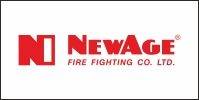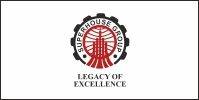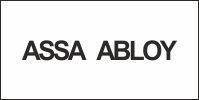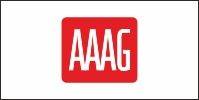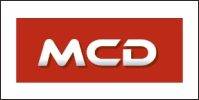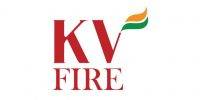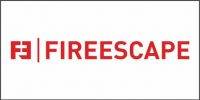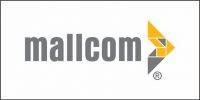To date, structural fire design has been largely based on extreme fire scenarios. Now, the University of Canterbury is investigating using probabilistic assessment to improve building performance during fires.
Currently, Structures are designed for fire by assessing their structural response under an extreme fire scenario. This has been treated as the worst case, but in fact 'extreme' and 'worst case' are not necessarily the same. The scenario traditionally used has been a post-flashover compartment fire with the highest peak temperature, based on the fuel in the compartment, the room geometry, lining materials and ventilation available.
In reality, the worst structural response could be due to:
- a long-duration low peak-temperature fire
- a localised fire (a fire in the immediate vicinity of an important structural element)
- a travelling fire (a fire that doesn't involve the entire fire compartment but rather progressively spreads though the compartment).
Probability a better measure
With such a large uncertainty in defining a reasonable worst-case fire, a better approach would be a probabilistic assessment of structural fire behaviour.
The University of Canterbury has begun research to develop a methodology for a probabilistic assessment of structures in fire conditions. The approach will consider different magnitudes of the various parameters and accurately predict structural behaviour (such as temperature, deflection and failure time).
Basics of structural design for fire
Structural design for fire conditions requires the prediction of compartment temperatures using a fire hazard model. Realistic temperatures in the structure during this fire are then estimated with a thermal model, followed by an assessment of structural response with a structural analysis model.
The three models are deterministic (i.e. single values for input parameters are used in the model calculations), but the different input parameters are generally random in nature. Deterministic models provide only a single variant of the actual range of possible behaviour for any given fire. The simplifying assumptions in the behaviour models may result in predictions that are overly conservative and cost more to construct or are unconservative and may cause structural failure.
Typical fire designs consider the worst-case fire for a compartment to be the time-temperature profile with the highest peak temperature. This usually occurs when the available ventilation for the fire is at a maximum, resulting from a complete loss of window glazing.
Problems highlighted
A maximum compartment fire temperature does not necessarily equate to critical temperatures in structural elements. The more important factor is often the duration of the fire rather than the peak compartment temperature.
A comparison of two fires – one with all glazing lost and the other with 50% glazing failure – and the temperatures they induce in a protected steel beam in the compartment is shown in Figure 1. The compartment is 10 × 6 × 3.5 m high with two windows – 3.5 × 2.8 m and 3.5 × 2.5 m – and a fire load of 800 MJ/m2.
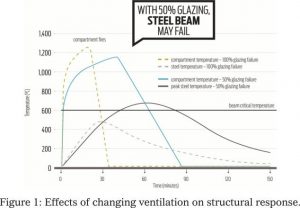 In Figure 1, the broken lines show the peak compartment temperature for 100% glazing failure and the corresponding steel temperature. The maximum steel temperature in the fire with 100% glazing failure is not high enough to cause concern.
In Figure 1, the broken lines show the peak compartment temperature for 100% glazing failure and the corresponding steel temperature. The maximum steel temperature in the fire with 100% glazing failure is not high enough to cause concern.
The solid lines show the lower peak compartment fire temperatures for the 50% glazing failure case with the matching steel temperature. For this case, with 50% glazing loss, the temperature of the protected beam exceeds the critical temperature.
Computing probabilities
The University of Canterbury research developing a methodology for probabilistic structural fire design will employ a performance-based earthquake engineering approach developed by the Pacific Earthquake Engineering Research (PEER) Center at the University of California.
In its standard form, the process computes annual probabilities, but it can be easily modified to compute the probability of exceeding different hazards during a certain period – notably the design life of the structure.
Defining measure and interrelationships
For structures in fire conditions, the process starts with defining an intensity measure for a fire hazard model. This is a variable that efficiently and sufficiently describes the intensity of fire. Examples include fire duration, peak fire temperature, fuel load, cumulative radiant heat, heat release rate and normalised heat release rate.
For a given type and value of intensity measure, there can be several time temperature profiles, and a single fire profile can be scaled to cover a range of the intensity measures, from a small value resulting in no damage to a large value causing structural collapse.
The intensity measure needs to correlate to an engineering demand parameter. This is a critical response parameter that has a strong correlation with damage and forms a strong basis for design decisions. Examples may be maximum deformation, maximum section temperature, time of failure and maximum bending moment.
The engineering demand parameter needs to be correlated with a damage measure, such as no damage, spalling (for concrete), and collapse, that is indicative of loss and cost. A decision variable can then be developed based on the acceptable repair cost for given damage measures.
The research aims to explore different parameters that could correlate well with structural fire response and could be used as intensity measures and engineering demand parameters for probabilistic risk assessment of structures under fire conditions.
A range of structural fires of varying fuel load, room lining materials, ventilation conditions and room geometries will be quantified in terms of potential intensity measures including:
- Peak temperatures
- Duration
- Cumulative radiant energy
- Heat release rate
- Normalised heat release rate.
- Testing simple and complex structures
The generated fires will also be applied to simple and complex structures to investigate the effects of individual intensity measures on structural behaviour. Monte Carlo simulations will be used for the multiple analyses required to determine ideal intensity measures for structural fire engineering analysis of buildings.
With the identification of ideal intensity measures, engineering demand parameters, damage measures and decision variables, probabilistic assessments of structural behaviour will become common, ensuring buildings are constructed to survive the worst probable fire in their lifetimes.













